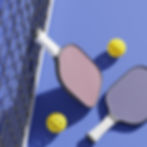Padel vs Pickleball - Battle of the Bats (And Balls)
Padel & Pickleball -Two fast-growing sports, two very different games
Padel and pickleball are both surging in popularity across the UK. Padel has seen a threefold increase in participation over the past year, with LTA figures showing around 400,000 adults and juniors playing at least once in the last 12 months. Pickleball, while not yet at the fever pitch seen in the US, is rapidly growing — with about 35,000 UK players and a 65% rise in membership over the past year.
So, what sets these two rising racket sports apart?
Rackets & Balls: Plastic vs. Fibreglass
Padel uses a solid bat. Think of a tennis racket’s compact cousin, usually made from carbon fibre or fibreglass. In contrast, pickleball paddles are thinner, made of plastic or composite materials, and feature a completely different head shape.
Then there's the ball. Padel uses a depressurised tennis ball, giving it a bit less bounce than the standard tennis version.

Pickleball, on the other hand, uses a perforated plastic ball, similar to a Wiffle ball, which stays low and plays slower off the court surface.

The Courts
This difference in bounce influences court design too. Pickleball courts are smaller, with lower nets and boundary lines more akin to badminton. They also feature a "no-volley zone" near the net, affectionately dubbed "the kitchen", which prevents players from dominating close to the net.

Padel’s standout feature? Enclosed glass walls. These aren’t just for show, they’re part of the game. Think glass palace meets squash arena. Players can bounce the ball off them, similar to squash, leading to long, tactical rallies that demand both precision and quick reflexes.

Rules of Play: Traditional vs Unique
Both sports share the same objective, hit the ball over the net and win points. While singles matches are possible in both, padel is predominantly a doubles game.
Scoring-wise, padel sticks to classic tennis rules: 15, 30, 40, game. Simple enough!
Pickleball, though, does things differently. Only the serving team can score points, games are played to 11, and a team must win by two clear points. The unique scoring can take a moment to grasp, but it adds to the game’s strategic flair.
Which is Easier to Play?
Think one of these sports is easier than the other? Think again. Both padel and pickleball demand quick reflexes, solid cardio, sharp strategy and the occasional shout of “Mine!” as you race for a loose ball.
What sets them apart, though, is their welcoming, social nature. They're ideal for players aged 9 to 90!
Find your nearest padel and pickle ball courts.
